Abstract
To assess the effects of intravenously administered acebutolol (1-20 mg every 4 hours for 24 hours) on cardiac rhythm and performance, we studied 72 patients with evolving myocardial infarction. Twenty-five patients were treated with acebutolol beginning 6 hours after the first increase in the level of plasma creatine kinase. Enzymatically estimated infarct size was compared with that of 25 controls matched for predicted infarct size. Observed infarct sizes were not significantly different in the 2 groups (37 +/- 5 and 30 +/- 5 CK-gram equivalents, respectively). Mean heart rate, diastolic blood pressure, and cardiac output declined from control values during treatment with acebutolol, but remained within the normal range. Mean pulmonary artery pressure and pulmonary artery occlusive pressure were unchanged. In a group of 22 treated patients matched with 22 control subjects for frequency of ventricular extrasystoles, acebutolol effected a prompt reduction in frequencies of ventricular extrasystoles and repetitive arrhythmias, whereas values were not significantly changed in controls during the corresponding intervals. Accordingly, acebutolol may be a useful antiarrhythmic agent in selected patients with acute myocardial infarction with adversely altering haemodynamic stability or enzymatically estimated infarct size.
Full text
PDF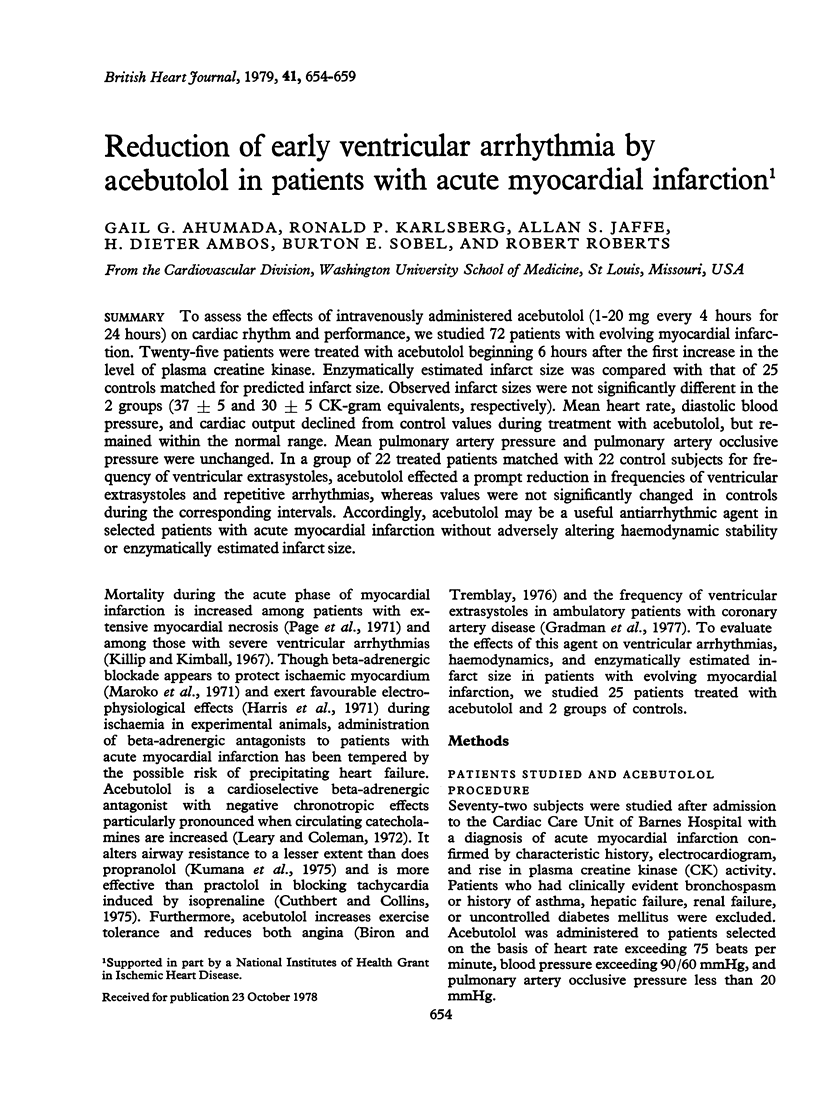
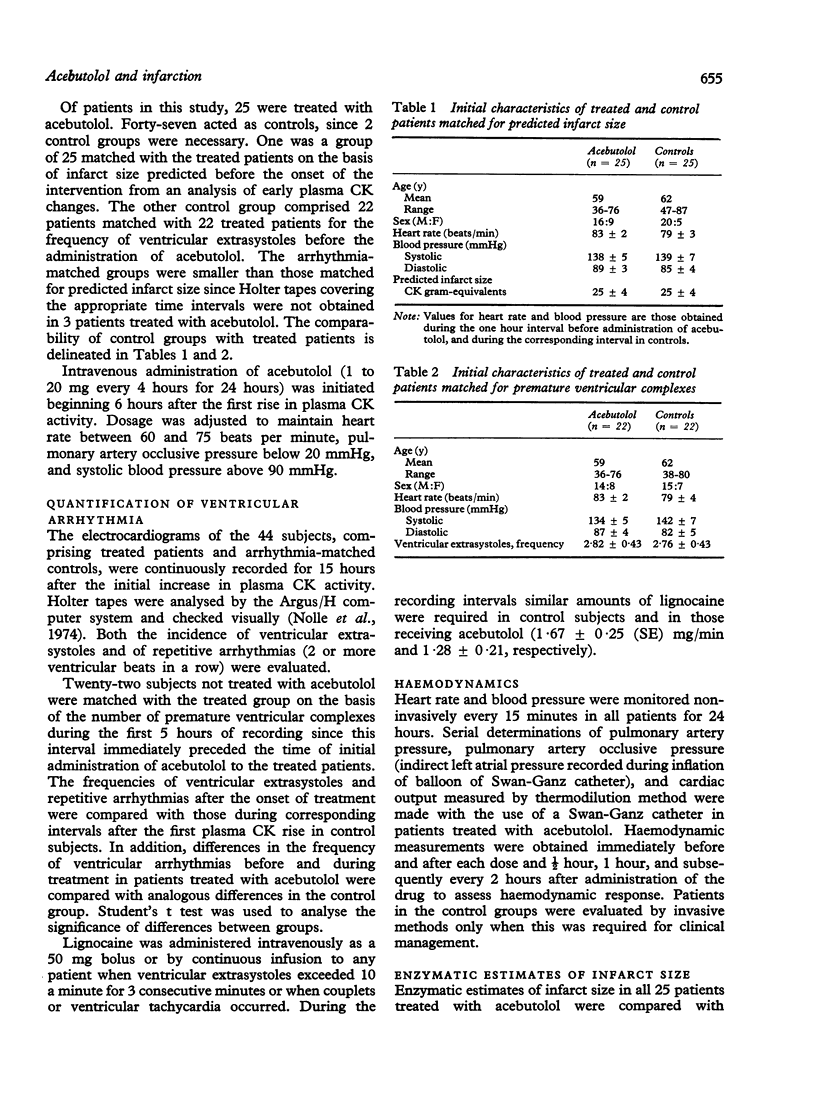
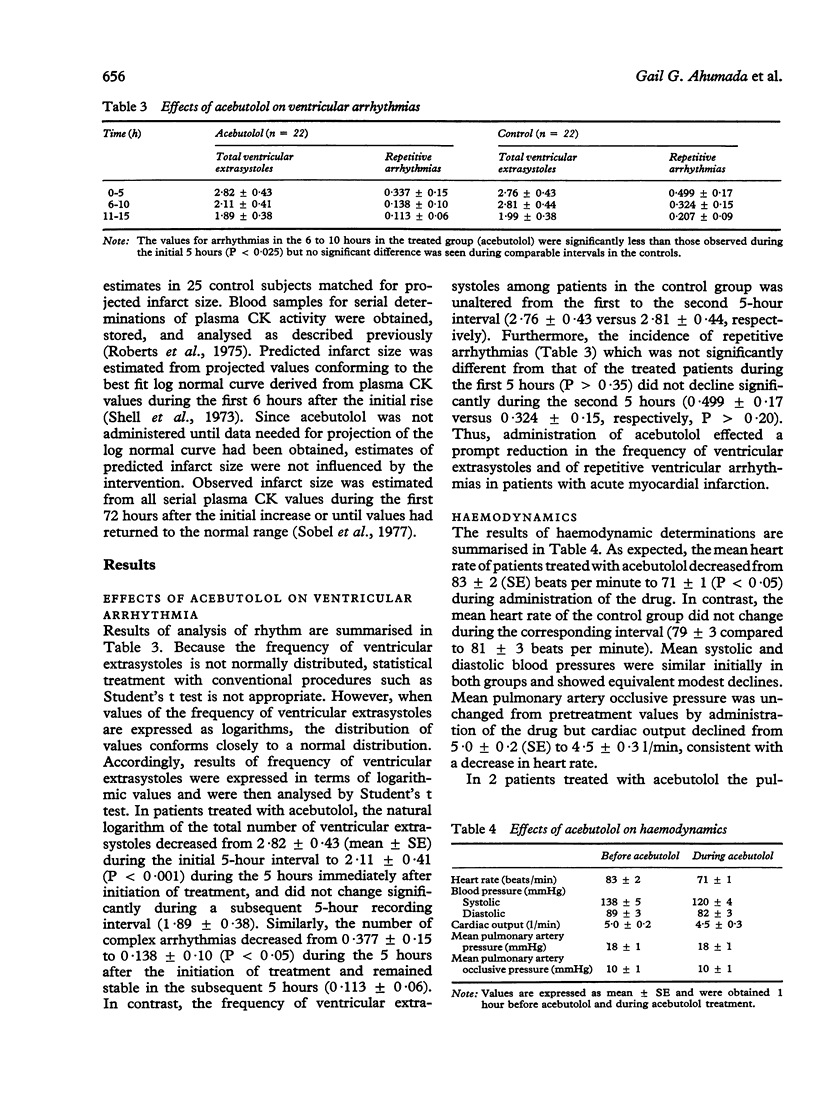
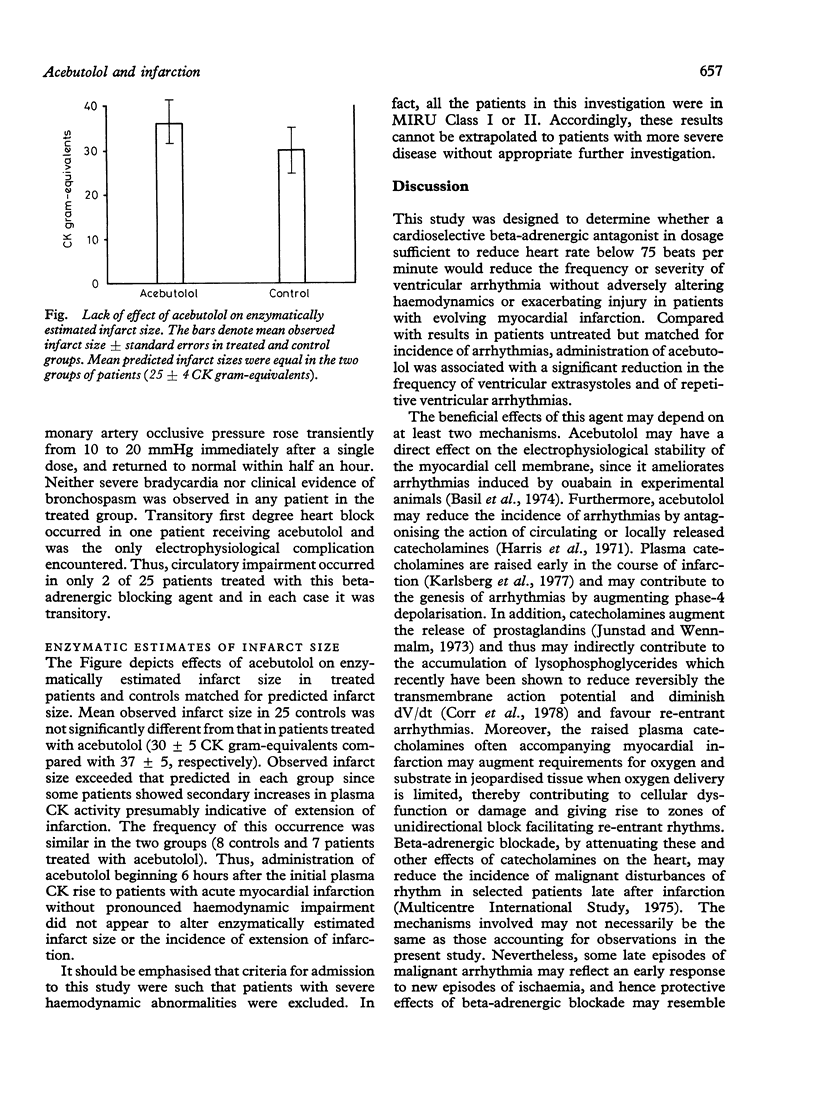
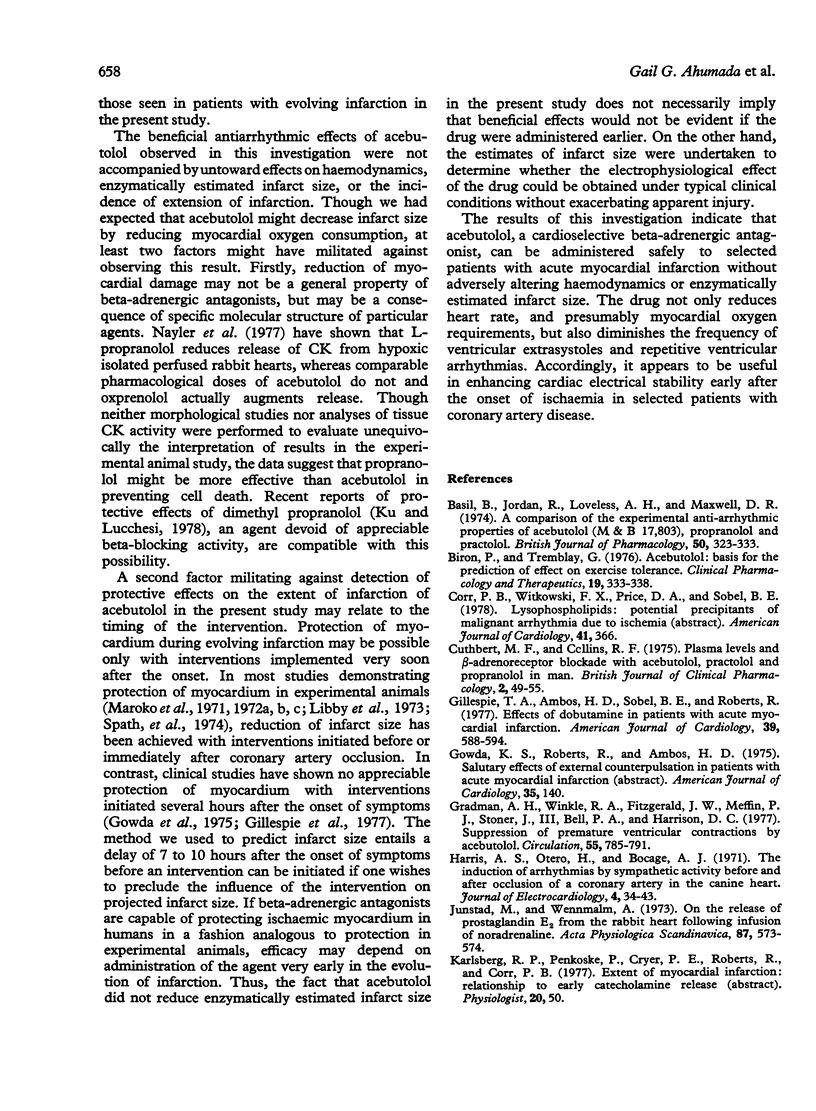

Selected References
These references are in PubMed. This may not be the complete list of references from this article.
- Basil B., Jordan R., Loveless A. H., Maxwell D. R. A comparison of the experimental anti-arrhythmic properties of acebutolol (M and B 17,803), propranolol and practolol. Br J Pharmacol. 1974 Mar;50(3):323–333. doi: 10.1111/j.1476-5381.1974.tb09607.x. [DOI] [PMC free article] [PubMed] [Google Scholar]
- Biron P., Tremblay G. Acebultolol: basis for the prediction of effect on exercise tolerance. Clin Pharmacol Ther. 1976 Mar;19(3):333–338. doi: 10.1002/cpt1976193333. [DOI] [PubMed] [Google Scholar]
- Cuthbert M. F., Collins R. F. Plasma levels and beta-adrenoceptor blockade with acebutolol, practolol and propranolol in man. Br J Clin Pharmacol. 1975 Feb;2(1):49–55. doi: 10.1111/j.1365-2125.1975.tb00471.x. [DOI] [PMC free article] [PubMed] [Google Scholar]
- Gillespie T. A., Ambos H. D., Sobel B. E., Roberts R. Effects of dobutamine in patients with acute myocardial infarction. Am J Cardiol. 1977 Apr;39(4):588–594. doi: 10.1016/s0002-9149(77)80170-7. [DOI] [PubMed] [Google Scholar]
- Gradman A. H., Winkle R. A., Fitzgerald J. W., Meffin P. J., Stoner J., 3rd, Bell P. A., Harrison D. C. Suppression of premature ventricular contractions by acebutolol. Circulation. 1977 May;55(5):785–791. doi: 10.1161/01.cir.55.5.785. [DOI] [PubMed] [Google Scholar]
- Harris A. S., Otero H., Bocage A. J. The induction of arrhythmias by sympathetic activity before and after occlusion of a coronary artery in the canine heart. J Electrocardiol. 1971;4(1):34–43. doi: 10.1016/s0022-0736(71)80048-1. [DOI] [PubMed] [Google Scholar]
- Junstad M., Wennmalm A. On the release of prostaglandin E2 from the rabbit heart following infusion of noradrenaline. Acta Physiol Scand. 1973 Apr;87(4):573–574. doi: 10.1111/j.1748-1716.1973.tb05425.x. [DOI] [PubMed] [Google Scholar]
- KU D. D., Lucchesi B. R. Effects of dimethyl propranolol (UM-272; SC-27761) on myocardial ischemic injury in the canine heart after temporary coronary artery occlusion. Circulation. 1978 Mar;57(3):541–548. doi: 10.1161/01.cir.57.3.541. [DOI] [PubMed] [Google Scholar]
- Killip T., 3rd, Kimball J. T. Treatment of myocardial infarction in a coronary care unit. A two year experience with 250 patients. Am J Cardiol. 1967 Oct;20(4):457–464. doi: 10.1016/0002-9149(67)90023-9. [DOI] [PubMed] [Google Scholar]
- Kumana C. R., Kaye C. M., Leighton M., Turner P., Hamer J. Cardiac and pulmonary effects of acebutolol. Lancet. 1975 Jul 19;2(7925):89–93. doi: 10.1016/s0140-6736(75)90001-x. [DOI] [PubMed] [Google Scholar]
- Leary W. P., Coleman A. J. Cardiovascular effects of M & B 17803A in man. S Afr Med J. 1972 Aug 26;46(34):1202–1203. [PubMed] [Google Scholar]
- Libby P., Maroko P. R., Bloor C. M., Sobel B. E., Braunwald E. Reduction of experimental myocardial infarct size by corticosteroid administration. J Clin Invest. 1973 Mar;52(3):599–607. doi: 10.1172/JCI107221. [DOI] [PMC free article] [PubMed] [Google Scholar]
- Maroko P. R., Bernstein E. F., Libby P., DeLaria G. A., Covell J. W., Ross J., Jr, Braunwald E. Effects of intraaortic balloon counterpulsation on the severity of myocardial ischemic injury following acute coronary occlusion. Counterpulsation and myocardial injury. Circulation. 1972 Jun;45(6):1150–1159. doi: 10.1161/01.cir.45.6.1150. [DOI] [PubMed] [Google Scholar]
- Maroko P. R., Kjekshus J. K., Sobel B. E., Watanabe T., Covell J. W., Ross J., Jr, Braunwald E. Factors influencing infarct size following experimental coronary artery occlusions. Circulation. 1971 Jan;43(1):67–82. doi: 10.1161/01.cir.43.1.67. [DOI] [PubMed] [Google Scholar]
- Maroko P. R., Libby P., Bloor C. M., Sobel B. E., Braunwald E. Reduction by hyaluronidase of myocardial necrosis following coronary artery occlusion. Circulation. 1972 Sep;46(3):430–437. doi: 10.1161/01.cir.46.3.430. [DOI] [PubMed] [Google Scholar]
- Maroko P. R., Libby P., Sobel B. E., Bloor C. M., Sybers H. D., Shell W. E., Covell J. W., Braunwald E. Effect of glucose-insulin-potassium infusion on myocardial infarction following experimental coronary artery occlusion. Circulation. 1972 Jun;45(6):1160–1175. doi: 10.1161/01.cir.45.6.1160. [DOI] [PubMed] [Google Scholar]
- Nayler W. G., Grau A., Yepez C. Beta-adrenoceptor antagonists and the release of creatine phosphokinase from hypoxic heart muscle. Cardiovasc Res. 1977 Jul;11(4):344–352. doi: 10.1093/cvr/11.4.344. [DOI] [PubMed] [Google Scholar]
- Page D. L., Caulfield J. B., Kastor J. A., DeSanctis R. W., Sanders C. A. Myocardial changes associated with cardiogenic shock. N Engl J Med. 1971 Jul 15;285(3):133–137. doi: 10.1056/NEJM197107152850301. [DOI] [PubMed] [Google Scholar]
- Roberts R., Henry P. D., Sobel B. E. An improved basis for enzymatic estimation of infarct size. Circulation. 1975 Nov;52(5):743–754. doi: 10.1161/01.cir.52.5.743. [DOI] [PubMed] [Google Scholar]
- Shell W. E., Lavelle J. F., Covell J. W., Sobel B. E. Early estimation of myocardial damage in conscious dogs and patients with evolving acute myocardial infarction. J Clin Invest. 1973 Oct;52(10):2579–2590. doi: 10.1172/JCI107450. [DOI] [PMC free article] [PubMed] [Google Scholar]
- Sobel B. E., Markham J., Roberts R. Factors influencing enzymatic estimates of infarct size. Am J Cardiol. 1977 Jan;39(1):130–132. doi: 10.1016/s0002-9149(77)80024-6. [DOI] [PubMed] [Google Scholar]
- Spath J. A., Jr, Lane D. L., Lefer A. M. Protective action of methylprednisolone on the myocardium during experimental myocardial ischemia in the cat. Circ Res. 1974 Jul;35(1):44–51. doi: 10.1161/01.res.35.1.44. [DOI] [PubMed] [Google Scholar]


